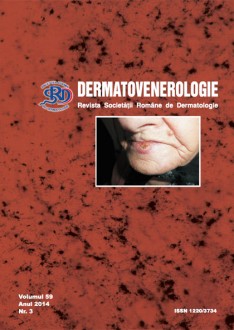Lip Squamous cell carcinoma (SCC) is an infiltrating and destructive malignant epithelial tumor, with potential for lymphatic and/or blood metastasizes, which represents 15-30% of all SCC of the cephalic extremity and 1/5 of the upper aerodigestive tract cancers.
We have performed a clinical, histopathological and immunohistochemical study, on a group of 43 patients hospitalized and treated in Craiova Dermatology Clinic in 2013-2014.
Patients and Methods. For each patient was elaborated an observation sheet including identification data, origin environment, profession, risk factors, medical history, location and tumor diameter, clinical form, histopathological examination and immunohistochemical investigations.
For the histopathological study the pieces were processed by the classical technique with paraffin embedding and sections were stained with Hematoxylin–Eosin. The histopathological evaluation focused on: the variety of squamous cell carcinoma; the degree of differentiation; the presence of perivascular and perineural invasion; the association with dysplastic lesions in the periphery of the tumor; the presence of residual malignant cells around the edges of surgical safety.
Ten cases have been processed immunohistochemical using the following antibodies p53, VEGF and Ki67. As visualization system it was used LSAB2 (Dako, code K0675) and as chromogen 3, 3’- diaminobenzidine tetrahydrochloride (Dako, code K3468). Negative controls were obtained by omitting the primary antibodies.
Results
In all 43 cases, the tumor was located at the lower lip level. Of these, 31 cases were at men and the rest of the 12 cases were present in women. From rural area were 37 cases. The age of the patients ranged between 40 and 87 years (mean age 70.86 years). Clinical forms: ulcerovegetant type of SCC (13 cases), ulcerative infiltrative type (10 cases), nodular type (9 cases), keratosic type (5 cases), ulcerate SCC (4 cases) and 2 cases were found to be carcinoma in situ.
In terms of histopathological examination moderately differentiated SCC was predominant (23 cases), followed by well differentiated type (13 cases) and poorly differentiated (2 cases).
In 3 patients we found verrucous carcinoma and the other two patients presented carcinoma in situ. Perineural and perivascular invasion was present in four patients, and in 26 cases were dysplastic changes at tumor periphery. At five patients we found residual malignant cells around the edges of surgical safety.
Immunohistochemical investigations have revealed that positive expression for VEGF was present in all the studied cases, being intensely positive in 8 cases (80%) and moderately positive in 2 cases (20%). The expressions of p53 is nuclear and was present in all the studied cases, was diffuse positive in 6 cases (60%) and focal positive in 4 cases (40%). The expressions of Ki-67 is nuclear, in 9 cases showed positivity in over 50% of the tumor cells (90%), in one case, the positivity being present in 10-50% of the tumor cells.
Conclusions
- SCC of the lip affects with predilection men past 60 years with long-standing exposure to the sun and who smoke;
- SCC of the lip onset occurs frequently on lesions with a malignant potential, especially in chronic keratosic cheilitis, highlighting the importance of early diagnosis and adequate treatment for preblastomatous cheilitis;
- The histopathological exam assesses the degree of differentiation, perineural and perivascular tumor invasion, the depth of invasion and the presence of residual malignant cells around the edges of surgical safety, thus appreciating the stage of tumor progression and the prognosis of SCC of the lip;
- Immunohistochemical investigations on the expression of VEGF, p53 and Ki67 in tumor cells showed positivity in all the 10 studied cases, suggesting their outcome and their progression capacity, counting to assess tumor development.
Clinical trials and experimental
RESEARCH OF PROGNOSTIC SIGNIFICANCE OF CLINICAL, HISTOLOGICAL AND IMMUNOHISTOCHEMICAL PARAMETERS IN LIP SQUAMOUS CELL CARCINOMA


